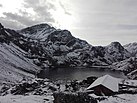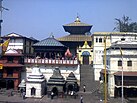Bagmati Province
This article needs additional citations for verification. (June 2017) |
Province No. 3 | |
|---|---|
|
From Top left to right Gaurishankar, Gosainkunda, Pashupatinath Temple, Patan Durbar Square, Swayambhunath, Bhaktapur Durbar Square, Hanuman Dhoka and One-horned rhinoceros at Chitwan National Park | |
 Location of Province No. 3 | |
 Map of Province No. 3, Nepal | |
| Country | |
| Formation | 20 September 2015 |
| Capital | Hetauda (Temporary) |
| Largest city | Kathmandu |
| Districts | 13 |
| Government | |
| • Body | Government of Province No. 3 |
| • Governor | Anuradha Koirala |
| • Chief Minister | Dormani Poudel (NCP) |
| • High Court | Patan High Court |
| • Provincial Assembly | Unicameral (110 seats) |
| • Parliamentary constituency | 33 |
| Area | |
| • Total | 20,300 km2 (7,800 sq mi) |
| • Rank | 5th |
| Population (2011) | |
| • Total | 5,529,452 |
| • Rank | 1st |
| • Density | 270/km2 (710/sq mi) |
| • Rank | 2nd |
| Demonym | Rajdhani Niwasi but Nepalese |
| Time zone | UTC+5:45 (NST) |
| Geocode | NP-TH |
| Main Official Language | Nepali (57.42%) |
| Other Official Language(s) | 1. Tamang (18.31%) 2. Nepal Bhasa (12.29%) |
| HDI | 0.560 (medium) |
| Literacy | 74.85% |
| Sex ratio | 98.77 ♂ /100 ♀ (2011) |
| Website | https://ocmcm.p3.gov.np/ |
Province No. 3 (proposed names: Nepalmandal,[1] or Bagmati) is one of the seven provinces of Nepal established by the country's new constitution of 20 September 2015.[2] Home to the country's capital Kathmandu, it is mostly hilly and mountainous, home to peaks including Gaurishankar, Iangtang, Jugal, and Ganesh. The province covers an area of 20,300 km2, about 14% of the country's total area, and has an altitude low enough to support deciduous, coniferous, and alpine forest and woodland. Temperature varies with altitude. Rainfall takes place mainly during the summer.
The province borders the Tibet Autonomous Region of China to the north, Province No. 1 to the east, Gandaki Pradesh to the west, and both Province No. 2 and the Indian state of Bihar to the south. As per a 17 January 2018 cabinet meeting, Hetauda has been declared the interim state capital. The most populous province of Nepal, it possesses rich cultural diversity, with resident communities and castes including Newar, Tamang, Sherpa, Tharu, Chepang, Jirel, Brahmin, Chhetri, Sherpa, Tharu, Chepang, Jirel, and more.[3] It hosted the highest number of voters in the last election for the House of Representatives and Provincial Assembly, which took place in 2017.
The normal demonym associated with the province depends on the resident's district or city, but Nepalmandali may be used in reference to the whole province.
Government and administration
The Governor acts as the head of the province while the Chief Minister is the head of the provincial government. The Chief Judge of the Patan High Court is the head of the judiciary.[4] The present Governor, Chief Minister and Chief Judge are Anuradha Koirala, Dormani Poudel and Tek Bahadur Moktan respectively.[5][6] The province has 110 provincial assembly constituencies and 35 House of Representative constituencies.[7]
Province No. 3 has a unicameral legislature, like all of the other provinces in Nepal. The term length of provincial assembly is five years. The Provincial Assembly of Province No. 3 is temporarily housed at the Regional Education Directorate in Hetauda.[8]
Administrative divisions
Province No. 3 is divided into 13 districts, which are listed below. A district is administrated by the head of the District Coordination Committee and the District Administration Officer. The districts are further divided into municipalities or rural municipalities. The municipalities include three metropolitan cities, one sub-metropolitan city and 41 municipalities. There are 74 rural municipalities in the province.[9]
- Bhaktapur District
- Chitwan District
- Dhading District
- Dolakha District
- Kathmandu District
- Kavrepalanchok District
- Lalitpur District
- Makwanpur District
- Nuwakot District
- Ramechhap District
- Rasuwa District
- Sindhuli District
- Sindhupalchok District
Religion in Province No. 3
Template:Largest cities of Province No. 3
See also
References
- ^ Shakya, Ajay Kranti. "३ नम्बर प्रदेशको नाम नेपालमण्डल नै उपयुक्त !". Sanchar Nepal (Pvt) Ltd. Retrieved 22 March 2018.
{{cite web}}: Cite has empty unknown parameter:|coauthors=(help) - ^ "Nepal Provinces". statoids.com. Retrieved 21 March 2016.
- ^ "Highest number of voters in province no. 3". Retrieved 15 April 2018.
- ^ "High Courts get their chief judges". Retrieved 27 April 2018.
- ^ "UML PP leader Dor Mani Paudel appointed CM of Province 3". The Himalayan Times. 11 February 2018. Retrieved 27 April 2018.
- ^ "President of Nepal administers oath to Chiefs of seven provinces | DD News". ddnews.gov.in. Retrieved 27 April 2018.
- ^ "CDC creates 495 constituencies". The Himalayan Times. 31 August 2017. Retrieved 27 April 2018.
- ^ "Preparations under way for assembly meeting". The Himalayan Times. 31 January 2018. Retrieved 27 April 2018.
- ^ "स्थानिय तह". 103.69.124.141. Retrieved 27 April 2018.








